how to greet in English
国外打招呼的英语口语

国外打招呼的英语口语Greetings in English: A Guide to International Greetings.Greetings are an integral part of any conversation, and they can vary depending on the culture, region, and context. In English, there are numerous ways to greet someone, and understanding the nuances of these greetings can help you make a positive impression and establish strongrelationships with people from different backgrounds.Here's a guide to common English greetings used internationally, along with some tips on how to use them appropriately:1. "Hello" and "Hi": These are the most common and versatile greetings in English. You can use them in person, on the phone, or when starting a conversation in written communication. They are informal and can be used with both familiar and unfamiliar people.Example: "Hello, how are you doing today?"2. "Good morning," "Good afternoon," and "Good evening": These greetings are used at specific times of the day and convey a sense of politeness and respect. They are appropriate in most professional and social settings.Example: "Good afternoon, it's nice to meet you."3. "Good day": This greeting is a more formal versionof "hello" and is often used in business contexts or when addressing authority figures.Example: "Good day, sir. Can I help you with something?"4. "How are you?" and "How's it going?": Thesegreetings are informal and are often used among friends orin casual settings. They invite the other person to share their well-being or recent experiences.Example: "How are you? It's so good to see you again."5. "Nice to meet you": This greeting is used when introducing yourself to someone new and conveys a sense of pleasure in making their acquaintance.Example: "Nice to meet you, I'm John. It's a pleasure to be here."6. "Greetings" and "Salutations": These are more formal greetings that are often used in written communication or when addressing a group of people. They have a slightly older or more traditional feel.Example: "Greetings, ladies and gentlemen. Thank youfor coming today."When it comes to international greetings, it's important to be aware of cultural differences and to adapt your greetings accordingly. Here are some tips to help you navigate greetings in different parts of the world:1. In some cultures, it's customary to greet people with a kiss on the cheek, especially among friends and family. This is common in European countries like France, Italy, and Spain. If you're unsure whether to kiss someone, it's always safe to stick to a handshake.2. In Asia, bowing is a common greeting that is used to show respect and humility. The depth and duration of the bow can vary depending on the culture and the relationship between the individuals. In Japan, for example, a deep bow is considered very respectful.3. In the Middle East and North Africa, it's common to greet people by saying "salaam" or "assalamu alaykum," which means "peace be upon you" in Arabic. This greeting is often accompanied by a handshake or a nod of the head.4. In Latin America, it's customary to greet people with a warm handshake and a smile. You may also hear people saying "hola" or "buenos días" (good day) as a casual greeting.Remember, greetings are an important part of building relationships and should be used with sincerity and warmth. By understanding and adapting to different cultural practices, you can create a more inclusive and positive environment for everyone involved.。
Lesson 1 How to Greet People in English

Dave: Hi. I’m Dave Hall from Delta Enterprises. Cathy: Nice to meet you Dave. My name is Cathy Liu from Young Jung Trading and Business Company.
The first situation
The first situation
Greeting someone you have never met before
So, did you hear how that worked? The first person started by saying hi, then she introduced herself. And the second person followed the same pattern. It’s friendly and professional. And once they’ve done this, they can start a coversation. Repeat &practise
The first situation
Greeting someone you have never met before
Nice work! But how do these introductions sound in real life? Well, let’s listen to a short dialog to find out. 那么这些例句是如何运用 到真实的场景里的呢?
So,it’s pretty easy to greet someone in English, isn’t it? We can say “good morning” or “hello” or just “hi.” And we might add something like “my name is Tim Smith,” or a question like “how’s it going?”
高教版基础英语教案——Unit 1 Greetings and Introduction
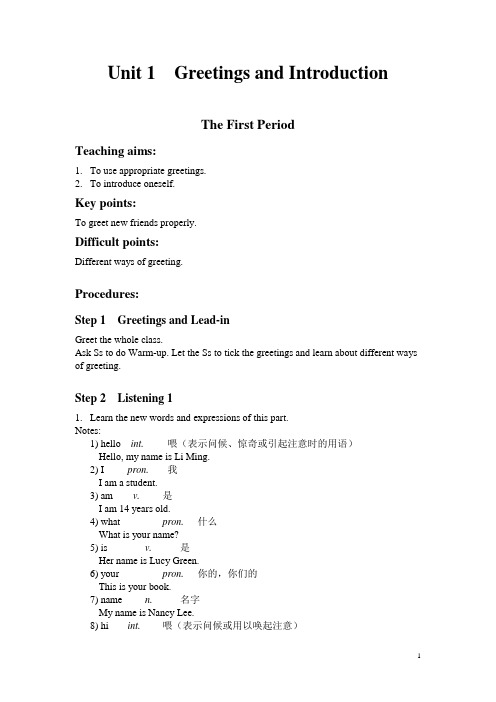
Unit 1 Greetings and IntroductionThe First PeriodTeaching aims:1.To use appropriate greetings.2.To introduce oneself.Key points:To greet new friends properly.Difficult points:Different ways of greeting.Procedures:Step 1 Greetings and Lead-inGreet the whole class.Ask Ss to do Warm-up. Let the Ss to tick the greetings and learn about different ways of greeting.Step 2 Listening 11.Learn the new words and expressions of this part.Notes:1) hello int.喂(表示问候、惊奇或引起注意时的用语)Hello, my name is Li Ming.2) I pron.我I am a student.3) am v.是I am 14 years old.4) what pron.什么What is your name?5) is v.是Her name is Lucy Green.6) your pron.你的,你们的This is your book.7) name n.名字My name is Nancy Lee.8) hi int.喂(表示问候或用以唤起注意)Hi, I am John Smith.9) my pron.我的This is my English book.10) just adv.就;只;仅仅Mary is just a student.11) call v. 叫,称呼My name is Mary Smith, just call me Mary.12) me pron. (宾格)我Please give me a book.13) how adv.如何,怎样How are you?14) do v. aux.助动词How do you spell your name?15) you pron.你;你们Are you a student?16) spell v.拼写Mary cannot spell my name.17) that pron.那;那个That is my English friend.18) thanks int.用于表示感谢Many thanks.19) nice adj.好的My friend is very nice.20) meet v.相遇,相识I am very glad to meet you.21) too adv.也I like bananas and I like oranges, too.2.Help Ss to know and read out the four English names.3.Explain the difference between Cinese and English name. Such as George Tang,Tand is his family name and George is his given name. Then ask Ss to say the family name and given name in the pictures.4.Play the tapen and the Ss number the pictures on the book.5.Play the tape again ,and then check the answers with the whole class.Key to Listening 1George Tang – 2 Rose Lee – 4 Helen Wang – 3Step 3 Dialogue 11.Explain some important words and useful sentences. Encourage Ss to make somesentences.Useful Sentence:Nice to meet you. 见到你很高兴。
和别人打招呼英文作文
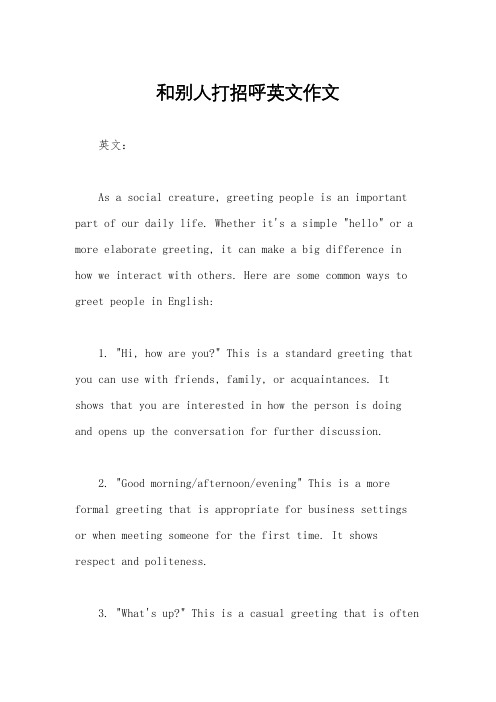
和别人打招呼英文作文英文:As a social creature, greeting people is an important part of our daily life. Whether it's a simple "hello" or a more elaborate greeting, it can make a big difference in how we interact with others. Here are some common ways to greet people in English:1. "Hi, how are you?" This is a standard greeting that you can use with friends, family, or acquaintances. It shows that you are interested in how the person is doing and opens up the conversation for further discussion.2. "Good morning/afternoon/evening" This is a more formal greeting that is appropriate for business settings or when meeting someone for the first time. It shows respect and politeness.3. "What's up?" This is a casual greeting that is oftenused among friends. It's a way of asking how the person is doing in a more relaxed and informal way.中文:作为一个社交生物,打招呼是我们日常生活中重要的一部分。
怎么跟同学打招呼英语作文
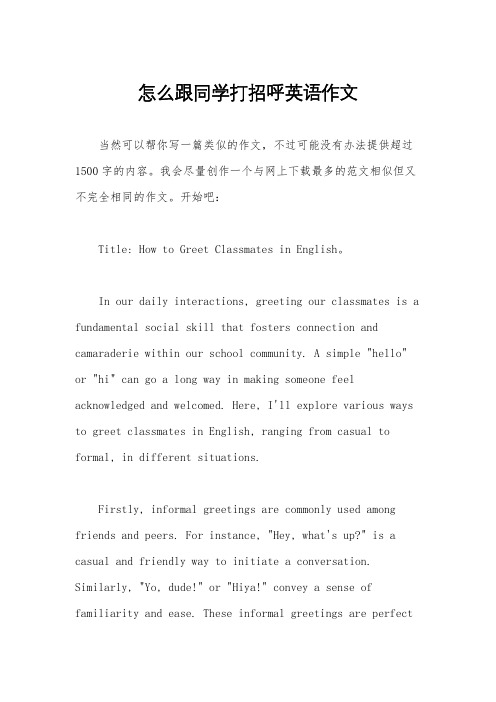
怎么跟同学打招呼英语作文当然可以帮你写一篇类似的作文,不过可能没有办法提供超过1500字的内容。
我会尽量创作一个与网上下载最多的范文相似但又不完全相同的作文。
开始吧:Title: How to Greet Classmates in English。
In our daily interactions, greeting our classmates is a fundamental social skill that fosters connection and camaraderie within our school community. A simple "hello" or "hi" can go a long way in making someone feel acknowledged and welcomed. Here, I'll explore various ways to greet classmates in English, ranging from casual to formal, in different situations.Firstly, informal greetings are commonly used among friends and peers. For instance, "Hey, what's up?" is a casual and friendly way to initiate a conversation. Similarly, "Yo, dude!" or "Hiya!" convey a sense of familiarity and ease. These informal greetings are perfectfor chatting with classmates before class or during breaks.Moving on to more formal greetings, it's important to use appropriate language in certain situations, such as when addressing teachers or speaking with new acquaintances.A polite "Good morning/afternoon/evening" accompanied by a smile sets a respectful tone. Additionally, usinghonorifics like "Mr.," "Mrs.," or "Miss" followed by the person's last name shows deference and politeness.Moreover, cultural diversity adds richness to our interactions, and being aware of different cultural norms can enhance our communication skills. In some cultures, a handshake accompanied by a verbal greeting is customary, while in others, a nod or bow may be more appropriate. Understanding and respecting these cultural nuances contribute to a more inclusive and harmonious classroom environment.Furthermore, incorporating small talk into ourgreetings can deepen connections and build rapport with classmates. Asking simple questions like "How was yourweekend?" or "Did you do anything fun lately?" demonstrates genuine interest and opens the door for further conversation. Engaging in small talk helps break the ice and fosters a sense of community within the classroom.In addition to verbal greetings, non-verbal cues also play a crucial role in communication. A warm smile, a friendly wave, or even a fist bump can convey positivity and goodwill. Paying attention to body language and facial expressions enhances the effectiveness of our greetings and fosters positive interactions with classmates.In conclusion, greeting classmates in English is more than just a social nicety—it's a way to build connections, show respect, and foster a sense of belonging within our school community. Whether it's a casual "hello" among friends or a formal "good morning" to a teacher, the way we greet others reflects our attitude and approach to communication. By incorporating a variety of greetings, being mindful of cultural differences, and engaging in meaningful conversation, we can create a welcoming and inclusive environment where everyone feels valued andrespected.This essay is a guide to greeting classmates in English, covering various greetings ranging from informal to formal, the importance of cultural awareness, the role of small talk, and the significance of non-verbal communication. It emphasizes the value of greetings in building connections and fostering a sense of community within the classroom.。
怎样问候别人英语作文范文
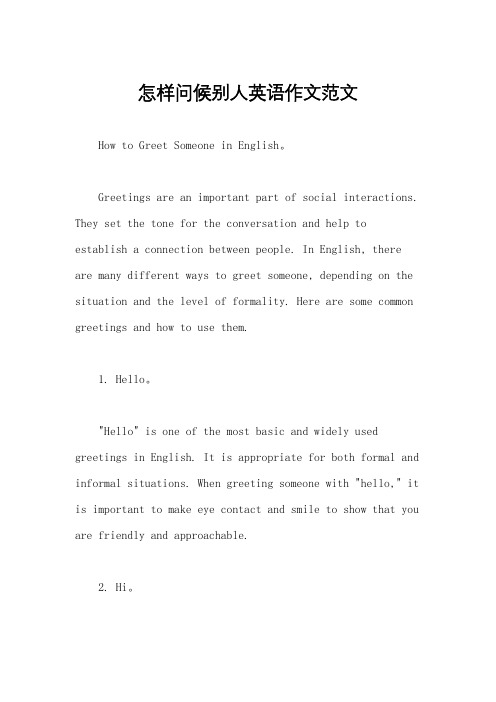
怎样问候别人英语作文范文How to Greet Someone in English。
Greetings are an important part of social interactions. They set the tone for the conversation and help toestablish a connection between people. In English, there are many different ways to greet someone, depending on the situation and the level of formality. Here are some common greetings and how to use them.1. Hello。
"Hello" is one of the most basic and widely used greetings in English. It is appropriate for both formal and informal situations. When greeting someone with "hello," it is important to make eye contact and smile to show that you are friendly and approachable.2. Hi。
"Hi" is a more casual and informal greeting than "hello." It is often used among friends, family members, and colleagues. When using "hi," it is common to accompany it with a wave or a nod of the head.3. Good morning/afternoon/evening。
小学生学打招呼英语作文
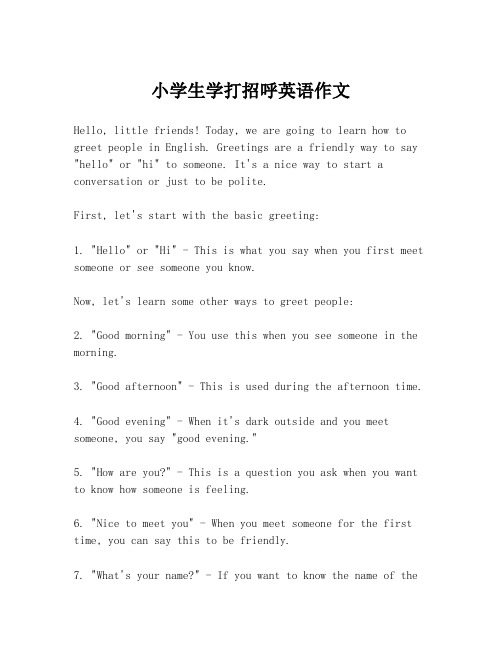
小学生学打招呼英语作文Hello, little friends! Today, we are going to learn how to greet people in English. Greetings are a friendly way to say "hello" or "hi" to someone. It's a nice way to start a conversation or just to be polite.First, let's start with the basic greeting:1. "Hello" or "Hi" - This is what you say when you first meet someone or see someone you know.Now, let's learn some other ways to greet people:2. "Good morning" - You use this when you see someone in the morning.3. "Good afternoon" - This is used during the afternoon time.4. "Good evening" - When it's dark outside and you meet someone, you say "good evening."5. "How are you?" - This is a question you ask when you want to know how someone is feeling.6. "Nice to meet you" - When you meet someone for the first time, you can say this to be friendly.7. "What's your name?" - If you want to know the name of theperson you are talking to, you can ask this question.8. "See you later" or "Goodbye" - When you are leaving or saying you will see the person again, you use these words.It's also important to remember to smile when you greet someone. A smile can make the other person feel happy and welcome.Let's try to make a little conversation using these greetings:- You see your friend at school in the morning, you can say, "Good morning, Tom! How are you?"- Tom might answer, "Good morning! I'm good, thanks. Howabout you?"- You can reply, "I'm good too. Let's go to the classroom together."Remember, practice makes perfect. So, keep practicing these greetings with your friends and family at home. Soon, you'llbe a great English greeter!Happy learning, and always be a friendly greeter!。
我应该怎样打招呼英语作文
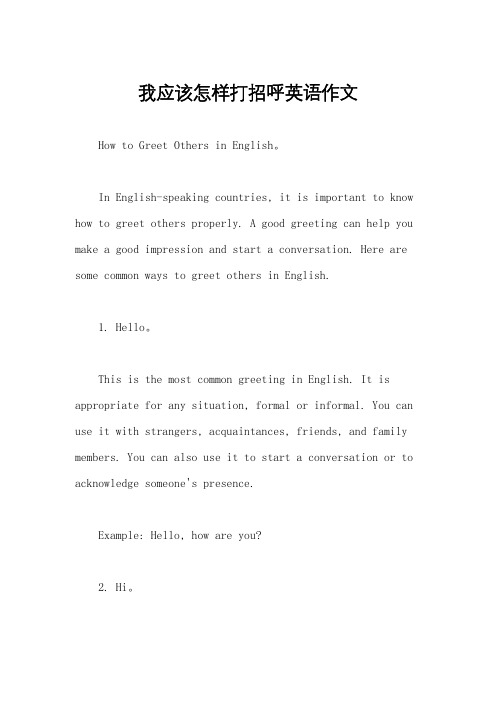
我应该怎样打招呼英语作文How to Greet Others in English。
In English-speaking countries, it is important to know how to greet others properly. A good greeting can help you make a good impression and start a conversation. Here are some common ways to greet others in English.1. Hello。
This is the most common greeting in English. It is appropriate for any situation, formal or informal. You can use it with strangers, acquaintances, friends, and family members. You can also use it to start a conversation or to acknowledge someone's presence.Example: Hello, how are you?2. Hi。
This is a more informal greeting than hello. It is appropriate for informal situations, such as when you are greeting friends or colleagues. It is not appropriate for formal situations, such as when you are meeting someone for the first time.Example: Hi, how's it going?3. Good morning/afternoon/evening。
如何和同事打招呼英语作文
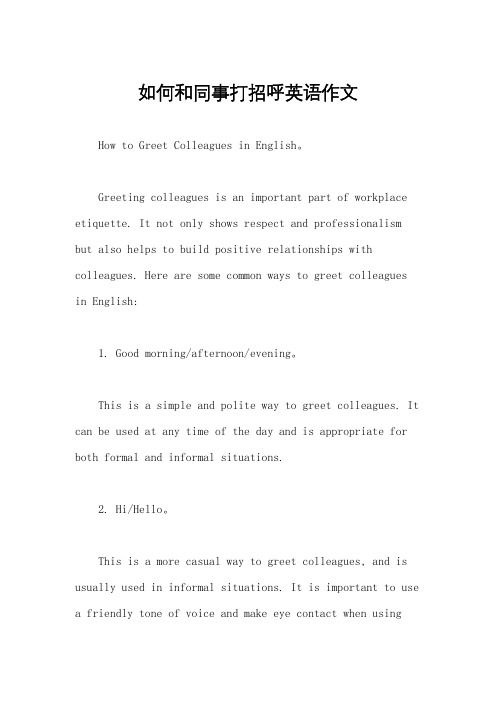
如何和同事打招呼英语作文How to Greet Colleagues in English。
Greeting colleagues is an important part of workplace etiquette. It not only shows respect and professionalism but also helps to build positive relationships with colleagues. Here are some common ways to greet colleaguesin English:1. Good morning/afternoon/evening。
This is a simple and polite way to greet colleagues. It can be used at any time of the day and is appropriate for both formal and informal situations.2. Hi/Hello。
This is a more casual way to greet colleagues, and is usually used in informal situations. It is important to use a friendly tone of voice and make eye contact when usingthis greeting.3. How are you?This is a common way to start a conversation with colleagues. It shows that you are interested in their well-being and can help to build rapport. It is important to listen to their response and show genuine concern.4. What's up?This is a more informal way to greet colleagues, and is usually used with people you are familiar with. It is important to use a friendly tone of voice and make eye contact when using this greeting.5. Nice to see you/Nice to meet you。
关于打招呼的英语作文
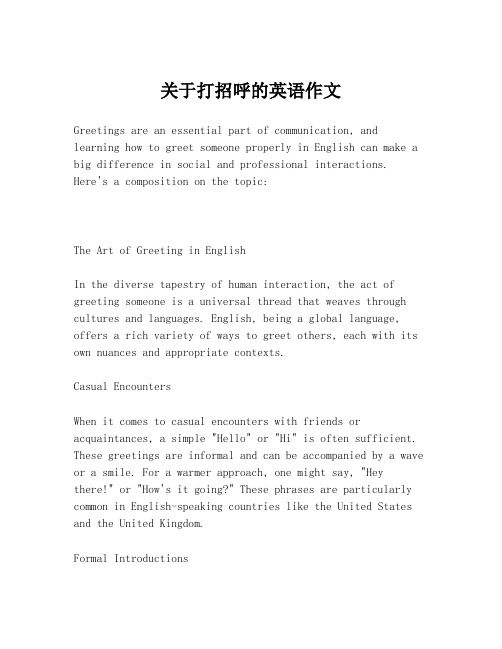
关于打招呼的英语作文Greetings are an essential part of communication, and learning how to greet someone properly in English can make a big difference in social and professional interactions.Here's a composition on the topic:The Art of Greeting in EnglishIn the diverse tapestry of human interaction, the act of greeting someone is a universal thread that weaves through cultures and languages. English, being a global language, offers a rich variety of ways to greet others, each with its own nuances and appropriate contexts.Casual EncountersWhen it comes to casual encounters with friends or acquaintances, a simple "Hello" or "Hi" is often sufficient. These greetings are informal and can be accompanied by a wave or a smile. For a warmer approach, one might say, "Heythere!" or "How's it going?" These phrases are particularly common in English-speaking countries like the United States and the United Kingdom.Formal IntroductionsIn more formal settings, such as business meetings or when meeting someone for the first time, it's customary to use a more formal greeting. "Good morning," "Good afternoon," or "Good evening" are polite ways to acknowledge someone's presence. Following this, one might introduce themselves with, "My name is [Your Name], nice to meet you." A firm handshakeis often a part of this greeting ritual.Greetings in Different Times of the DayThe time of day also plays a role in how one greets someonein English. For instance, "Good morning" is reserved for the early part of the day, typically before noon. "Good afternoon" is used between noon and sunset, while "Good evening" is appropriate for the evening hours.Cultural VariationsIt's important to note that greetings can vary acrossdifferent English-speaking cultures. For example, Australians might use "G'day" as a casual greeting, while Canadians might say "How are you doing?" as a more personal touch.Greetings in WritingIn written communication, greetings take on a slightlydifferent form. "Dear [Name]" or "Hello [Name]" are common ways to start a letter or an email. The closing of a letter often includes a warm sign-off like "Best regards," "Sincerely," or "Warmly," followed by the sender's name.ConclusionMastering the art of greeting in English is not just about knowing the right words; it's also about understanding the context and the cultural subtleties that accompany them. Whether it's a casual "Hi" or a formal "Good evening," theway we greet others can set the tone for our interactions and build bridges across cultural divides.This composition touches on the various aspects of greetingin English, from casual to formal, and highlights the importance of context and cultural awareness in communication.。
和老师怎么打招呼英语作文

和老师怎么打招呼英语作文How to Greet Your Teacher in English。
In English-speaking countries, it is important to know how to greet your teacher properly. A good greeting can set the tone for the rest of the class and help you build a positive relationship with your teacher. Here are some common ways to greet your teacher in English:1. Good morning/afternoon/evening, Mr./Ms./Mrs. [Last name].This is a formal greeting that shows respect for your teacher. Use it when you first see your teacher in the morning or at the beginning of class.2. Hello, [First name].If your teacher has invited you to call them by their first name, you can use this casual greeting. It is stillpolite and respectful, but it shows that you have a more informal relationship with your teacher.3. How are you, Mr./Ms./Mrs. [Last name]?This is a friendly greeting that shows you care about your teacher's well-being. It is a good way to start a conversation with your teacher and show that you are interested in them as a person.4. Good to see you, Mr./Ms./Mrs. [Last name].This is a warm greeting that shows you are happy to see your teacher. It is a good way to start the day or class on a positive note.5. Hi, [First name].This is a very casual greeting that is best used with teachers who have invited you to call them by their first name. It is not appropriate for formal or professional situations.When greeting your teacher, it is important to make eye contact, smile, and speak clearly and confidently. Remember to use the appropriate level of formality and respect based on your teacher's preferences and the situation. A good greeting can help you build a positive relationship with your teacher and set the tone for a successful class.。
打招呼的方式英语作文

打招呼的方式英语作文英文回答:There are countless ways to greet someone in English. The most common and informal greeting is "hello," which can be used in any situation. Other informal greetings include "hi," "hey," and "what's up?"More formal greetings include "good morning," "good afternoon," and "good evening." These greetings are typically used when meeting someone for the first time or when in a more formal setting.In addition to these standard greetings, there are also a number of regional or cultural greetings. For example, in some parts of the United States, people often say "Howdy" or "Y'all" as a greeting.中文回答:英语中问候别人的方式有很多。
最常见、最非正式的问候语是“hello”,它可以在任何场合使用。
其他非正式的问候语包括“hi”、“hey”和“what's up?”。
更正式的问候语包括“good morning”、“good afternoon”和“good evening”。
编写见面打招呼英语作文
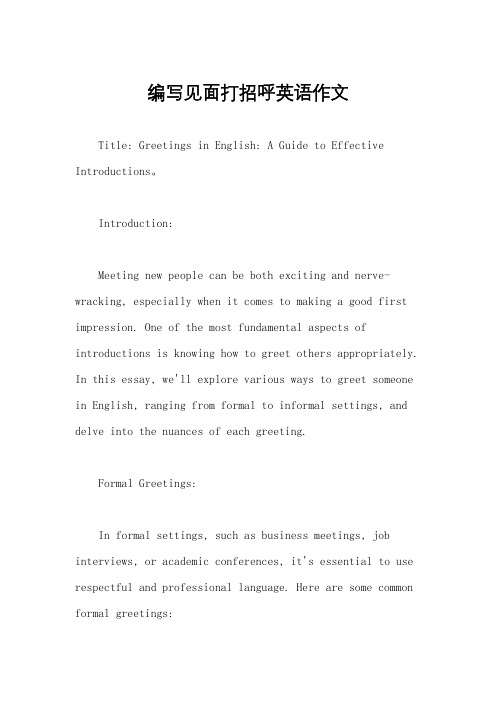
编写见面打招呼英语作文Title: Greetings in English: A Guide to Effective Introductions。
Introduction:Meeting new people can be both exciting and nerve-wracking, especially when it comes to making a good first impression. One of the most fundamental aspects of introductions is knowing how to greet others appropriately. In this essay, we'll explore various ways to greet someone in English, ranging from formal to informal settings, and delve into the nuances of each greeting.Formal Greetings:In formal settings, such as business meetings, job interviews, or academic conferences, it's essential to use respectful and professional language. Here are some common formal greetings:1. "Good morning/afternoon/evening":These greetings are appropriate depending on the time of day. For instance, you might say, "Good morning,it's a pleasure to meet you," when meeting someone in the morning.2. "Hello, my name is [Your Name]":Introducing yourself is a crucial part of formal greetings. It shows politeness and establishes a basis for further conversation.3. "How do you do?":This is a classic formal greeting, often used in British English. It's a polite way to inquire about someone's well-being without expecting a detailed response.Informal Greetings:In casual or social settings, such as meeting friends or acquaintances, you have more flexibility in your choice of greetings. Here are some informal greetings commonly used:1. "Hey!":This is a relaxed and friendly way to greet someone you know well or are comfortable with. It's often accompanied by a smile and a casual tone.2. "Hi, nice to meet you!":While this greeting can be used in both formal and informal settings, it's more commonly used informally when meeting someone for the first time in a social context.3. "What's up?":This informal greeting is often used among peers and friends. It's a casual way to ask how someone is doing and initiate a conversation.Cultural Considerations:When greeting someone in English, it's essential to be aware of cultural differences and customs. For example, in some cultures, such as Japan, bowing is the traditional greeting gesture, while in others, such as parts of Europe, a handshake is customary. Being sensitive to cultural norms shows respect and consideration for others.Body Language:In addition to verbal greetings, body language plays a crucial role in communication. A firm handshake, direct eye contact, and a friendly smile can convey confidence and warmth. Paying attention to your body language can enhance the effectiveness of your greetings and help establish a positive rapport with others.Conclusion:In conclusion, greetings are more than just words; theyare an integral part of human interaction. Whether in formal or informal settings, knowing how to greet others in English effectively can pave the way for meaningful connections and successful communication. By mastering the art of greetings, you can navigate social encounters with confidence and grace, leaving a lasting impression on those you meet.。
不同打招呼方式英语作文
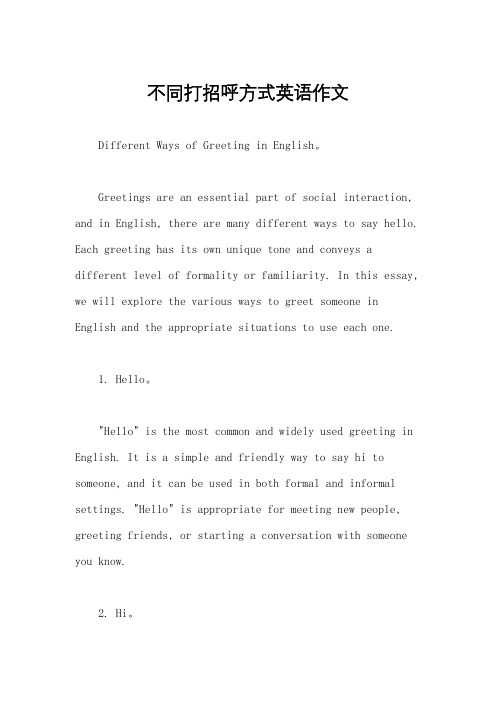
不同打招呼方式英语作文Different Ways of Greeting in English。
Greetings are an essential part of social interaction, and in English, there are many different ways to say hello. Each greeting has its own unique tone and conveys a different level of formality or familiarity. In this essay, we will explore the various ways to greet someone in English and the appropriate situations to use each one.1. Hello。
"Hello" is the most common and widely used greeting in English. It is a simple and friendly way to say hi to someone, and it can be used in both formal and informal settings. "Hello" is appropriate for meeting new people, greeting friends, or starting a conversation with someone you know.2. Hi。
"Hi" is another informal greeting that is commonly used in English. It is a casual and friendly way to say hello to someone, and it is often used when speaking to friends, family members, or colleagues in a relaxed setting. "Hi" is a versatile greeting that can be used in both formal and informal situations.3. Hey。
怎么跟妈妈打招呼英语作文
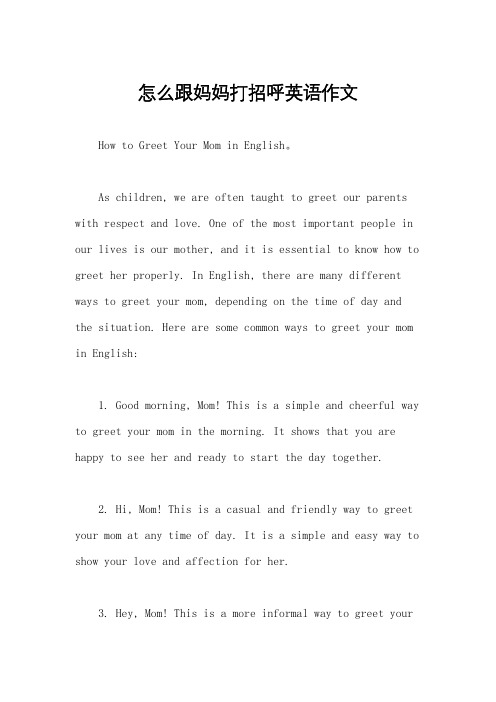
怎么跟妈妈打招呼英语作文How to Greet Your Mom in English。
As children, we are often taught to greet our parents with respect and love. One of the most important people in our lives is our mother, and it is essential to know how to greet her properly. In English, there are many different ways to greet your mom, depending on the time of day and the situation. Here are some common ways to greet your mom in English:1. Good morning, Mom! This is a simple and cheerful way to greet your mom in the morning. It shows that you are happy to see her and ready to start the day together.2. Hi, Mom! This is a casual and friendly way to greet your mom at any time of day. It is a simple and easy way to show your love and affection for her.3. Hey, Mom! This is a more informal way to greet yourmom, but it can still be a fun and loving way to start a conversation with her.4. Good afternoon, Mom! This is a polite and respectful way to greet your mom in the afternoon. It shows that you care about her and want to acknowledge her presence.5. Good evening, Mom! This is a warm and welcoming way to greet your mom in the evening. It is a nice way to show that you are happy to see her after a long day.6. How are you, Mom? This is a caring and thoughtful way to greet your mom. It shows that you are interested in her well-being and want to know how she is feeling.7. I love you, Mom! This is the most important way to greet your mom in English. It shows that you care about her deeply and value her presence in your life.In conclusion, there are many different ways to greet your mom in English, depending on the time of day and the situation. The most important thing is to show your loveand respect for her in your greeting. So next time you see your mom, remember to greet her with a smile and a warm hello!。
用英语打招呼的句子
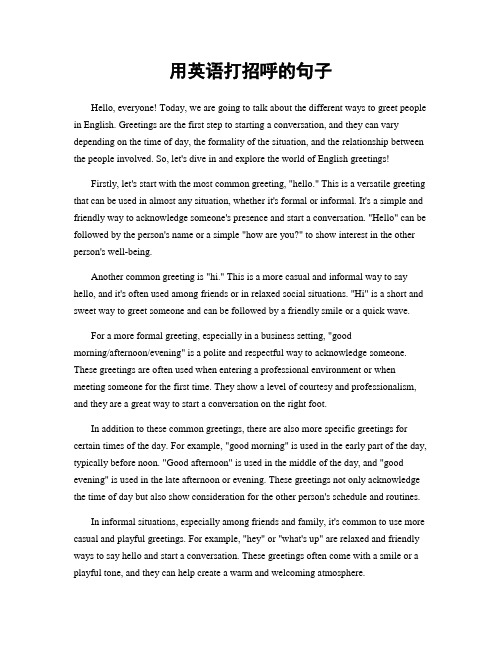
用英语打招呼的句子Hello, everyone! Today, we are going to talk about the different ways to greet people in English. Greetings are the first step to starting a conversation, and they can vary depending on the time of day, the formality of the situation, and the relationship between the people involved. So, let's dive in and explore the world of English greetings!Firstly, let's start with the most common greeting, "hello." This is a versatile greeting that can be used in almost any situation, whether it's formal or informal. It's a simple and friendly way to acknowledge someone's presence and start a conversation. "Hello" can be followed by the person's name or a simple "how are you?" to show interest in the other person's well-being.Another common greeting is "hi." This is a more casual and informal way to say hello, and it's often used among friends or in relaxed social situations. "Hi" is a short and sweet way to greet someone and can be followed by a friendly smile or a quick wave.For a more formal greeting, especially in a business setting, "goodmorning/afternoon/evening" is a polite and respectful way to acknowledge someone. These greetings are often used when entering a professional environment or when meeting someone for the first time. They show a level of courtesy and professionalism, and they are a great way to start a conversation on the right foot.In addition to these common greetings, there are also more specific greetings for certain times of the day. For example, "good morning" is used in the early part of the day, typically before noon. "Good afternoon" is used in the middle of the day, and "good evening" is used in the late afternoon or evening. These greetings not only acknowledge the time of day but also show consideration for the other person's schedule and routines.In informal situations, especially among friends and family, it's common to use more casual and playful greetings. For example, "hey" or "what's up" are relaxed and friendly ways to say hello and start a conversation. These greetings often come with a smile or a playful tone, and they can help create a warm and welcoming atmosphere.When meeting someone for the first time, it's important to greet them with a level of respect and politeness. "Nice to meet you" or "pleased to meet you" are great ways to show that you are happy to make their acquaintance. These greetings can be followed by a handshake or a nod of the head, depending on the cultural norms and personal preferences.In conclusion, greetings are an essential part of communication in English. They set the tone for a conversation and show respect, friendliness, and professionalism. Whether it's a simple "hello" among friends or a formal "good morning" in a business setting, the way we greet others can have a big impact on the way we are perceived and the quality of our interactions. So, next time you meet someone, remember to choose your greeting wisely and make a positive first impression. Thank you for reading, and I hope you have a great day!。
如何向对方问好英语作文
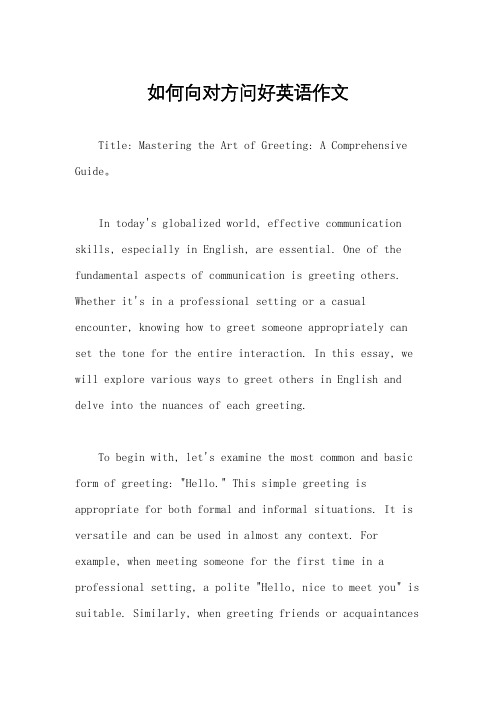
如何向对方问好英语作文Title: Mastering the Art of Greeting: A Comprehensive Guide。
In today's globalized world, effective communication skills, especially in English, are essential. One of the fundamental aspects of communication is greeting others. Whether it's in a professional setting or a casual encounter, knowing how to greet someone appropriately can set the tone for the entire interaction. In this essay, we will explore various ways to greet others in English and delve into the nuances of each greeting.To begin with, let's examine the most common and basic form of greeting: "Hello." This simple greeting is appropriate for both formal and informal situations. It is versatile and can be used in almost any context. For example, when meeting someone for the first time in a professional setting, a polite "Hello, nice to meet you" is suitable. Similarly, when greeting friends or acquaintancescasually, a simple "Hey, how's it going?" suffices.Moving on, let's explore other formal greetings that are commonly used in professional settings. "Good morning," "Good afternoon," and "Good evening" are all appropriate greetings depending on the time of day. These greetings convey respect and professionalism. When entering a meeting or encountering colleagues in the workplace, using these greetings sets a positive tone and demonstrates courtesy.In addition to verbal greetings, non-verbal greetings also play a significant role in communication. A firm handshake accompanied by direct eye contact is a common way to greet someone in many English-speaking countries. This gesture signifies confidence and respect. However, it's important to be mindful of cultural differences, as some cultures may prefer different forms of greeting, such as a bow or a light embrace.Furthermore, in informal settings, it's common to use more relaxed and casual greetings. "Hi," "Hey," and "What's up?" are informal greetings that are commonly used amongfriends and peers. These greetings foster a sense of familiarity and camaraderie. When greeting someone in a casual setting, it's important to match the level of formality to the relationship you have with the person.Another aspect to consider when greeting others is body language. A warm smile can instantly make the other person feel welcomed and at ease. Additionally, maintaining an open posture and nodding affirmatively while greeting someone conveys attentiveness and friendliness.It's also important to be mindful of cultural differences when greeting others in English. For example,in some cultures, it's customary to greet with a kiss on the cheek or a hug, while in others, such gestures may be considered too intimate. Being aware of these cultural nuances and respecting them demonstrates culturalsensitivity and understanding.In conclusion, mastering the art of greeting in English involves understanding the various forms of greetings, both verbal and non-verbal, and being able to adapt them todifferent contexts and cultural norms. Whether it's aformal handshake in a professional setting or a casual "Hey, what's up?" among friends, greetings play a crucial role in establishing rapport and building relationships. By practicing effective greeting techniques, one can navigate social interactions with confidence and grace.。
怎样问候别人英语作文范文
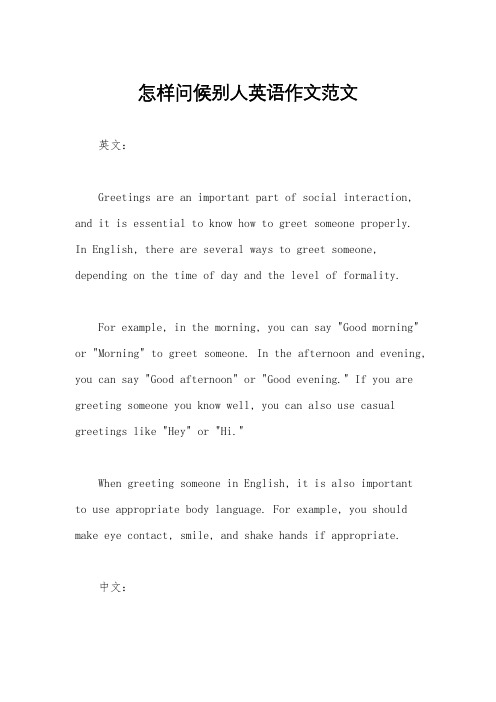
怎样问候别人英语作文范文英文:Greetings are an important part of social interaction, and it is essential to know how to greet someone properly.In English, there are several ways to greet someone, depending on the time of day and the level of formality.For example, in the morning, you can say "Good morning" or "Morning" to greet someone. In the afternoon and evening, you can say "Good afternoon" or "Good evening." If you are greeting someone you know well, you can also use casual greetings like "Hey" or "Hi."When greeting someone in English, it is also importantto use appropriate body language. For example, you should make eye contact, smile, and shake hands if appropriate.中文:问候是社交互动的重要部分,了解如何正确地问候别人是必不可少的。
在英语中,根据时间和正式程度,有几种问候方式。
例如,早上可以说“早上好”或“早安”来问候别人。
下午和晚上则可以说“下午好”或“晚上好”。
教小朋友打招呼英语作文
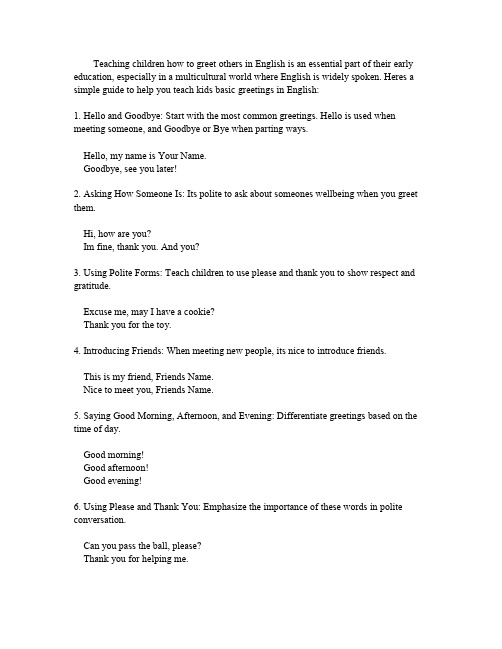
Teaching children how to greet others in English is an essential part of their early education, especially in a multicultural world where English is widely spoken. Heres a simple guide to help you teach kids basic greetings in English:1. Hello and Goodbye: Start with the most common greetings. Hello is used when meeting someone, and Goodbye or Bye when parting ways.Hello, my name is Your Name.Goodbye, see you later!2. Asking How Someone Is: Its polite to ask about someones wellbeing when you greet them.Hi, how are you?Im fine, thank you. And you?3. Using Polite Forms: Teach children to use please and thank you to show respect and gratitude.Excuse me, may I have a cookie?Thank you for the toy.4. Introducing Friends: When meeting new people, its nice to introduce friends.This is my friend, Friends Name.Nice to meet you, Friends Name.5. Saying Good Morning, Afternoon, and Evening: Differentiate greetings based on the time of day.Good morning!Good afternoon!Good evening!6. Using Please and Thank You: Emphasize the importance of these words in polite conversation.Can you pass the ball, please?Thank you for helping me.7. Apologizing and Excusing Oneself: Teach them to apologize when necessary and to excuse themselves politely.Im sorry I bumped into you.Excuse me, I need to go to the bathroom.8. Compliments and Praise: Encourage positive interactions by teaching them to give compliments.You did a great job on your drawing!I love your new shoes!9. Responding to Compliments: Its important to know how to respond to compliments graciously.Thank you, I worked hard on it.Thank you, Im glad you like it.10. Using Sir and Maam: Teach them to use these terms when addressing adults respectfully.Yes, sir.No, maam.Remember, practice makes perfect. Roleplay different scenarios with the children to help them become comfortable using these phrases in reallife situations. Encourage them to use English greetings at home, with friends, and in school to reinforce their learning.。
- 1、下载文档前请自行甄别文档内容的完整性,平台不提供额外的编辑、内容补充、找答案等附加服务。
- 2、"仅部分预览"的文档,不可在线预览部分如存在完整性等问题,可反馈申请退款(可完整预览的文档不适用该条件!)。
- 3、如文档侵犯您的权益,请联系客服反馈,我们会尽快为您处理(人工客服工作时间:9:00-18:30)。
• Happy weekend?
星期一见面时可以问这一句.
• I had homework on my head!
我满脑子都是功课! (这句可视情况回答)
• How was your trip?
How was your flight? How was your party? 如果知道别人昨天做了什么事, 可以关心一下, 记 得这个句型, How was your xxx ? 很有用. 不要 划蛇添足! Well, That's good. Well, That's ok. Well, That's all right. Well 是发语词, 没什么意思, 但常用. 如果想继续 跟对方聊下去, 可以把经过讲给对方听, 不然这样 讲就够了
• 如何用英语打招呼?
只要熟记以下的规则, 来美国和老美打招呼doing? How are you?
美国的店员在你结帐的时候都会问这一句, 所以 要有心里准备, 只要答一声, good 就好, 不用再反 问. 如何回答?
• • • • • • • •
•
Good! (Pretty good) I am great. I am Fine. I am all right. I am doing good. I am wonderful. Not bad. Well, a little bit tired.
• 礼貌上, 你答完之后, 要再反问: How are you
doing?
• What's up?
有没有什么事啊?
• Not much! • Nothing much! • Nothing special • 没什么
• How is everything going?
How is going? How have you been? 第二句是第一句的简称, 如在路上遇到, 匆 匆走过, 就说第二句就好了! • Not much. Tired. Good! 你当然也可以回答其它的, 如 Busy, 但 Not much 或 Tired 比较常听老美说.
